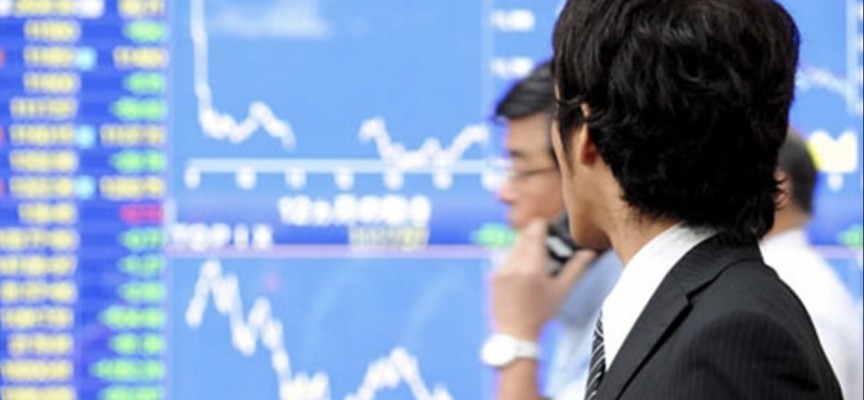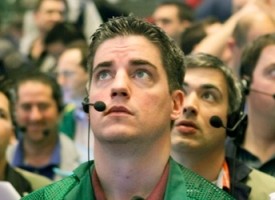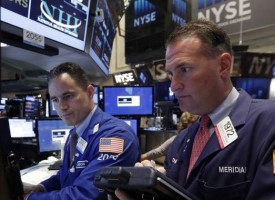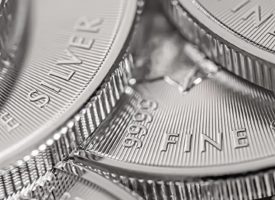Here is a look at panic and euphoria as we kick off Tuesday’s trading…
Panic & Euphoria
January 21 (King World News) – Peter Boockvar: For those who try to predict where markets will be 12 months from now, however difficult and silly a guess, throw out all your models and historical references and just measure the mood at Davos this week and do the opposite. It worked perfectly the last two years as each year ended exactly opposite of the Davos mood in which it began.
We’ve been looking at the elevated market sentiment over the past few weeks in a variety of metrics. Here is another one from Citi which is published each weekend in Barron’s. According to Citi, “The panic/euphoria model is a gauge of investor sentiment…Historically, a reading below panic supports a better than 95% likelihood that stock prices will be higher one year later, while euphoria levels generate a better than 80% probability of stock prices being lower one year later.” The index currently at .34 is just below the .41 which indicates euphoria according to Citi.

SARS
The virus in China has everyone remembering SARS again which hit that region between November 2002 and July 2003. Wikipedia said there were about 8,000 cases where 774 people died. From late November 2002 to late April 2003 the Hang Seng in particular fell 17%. This was a panic move as the whole region was in its own personal panic that drove the decline in confidence which in turn affected the economy. I don’t want to downplay the current affliction but it will get resolved sooner rather than later and the actual economic impact should be negligible. That reality though didn’t stop all Asian markets except Taiwan to trade in the red with the Shanghai comp in particular down 1.4%, the Hang Seng down twice that and the H share index lower by 3.2%. Copper traded down by 1.6%, lower for a 4th day and all the travel related names got hit hard.
Trouble In Japan
The BoJ met today but did nothing as expected. Other than eventually tightening, if that is even possible for them, there is really nothing left for them to do on the easing side other than completely nationalizing all the bonds and stocks outstanding. They are though about half way there. Here are some quotes from Kuroda who seems very intent on just sitting tight and has no appetite yet for tightening even if the global economy is seeing a bottom in some eyes. “Progress in US/China trade talks and Brexit have led to an improvement in risk sentiment, pushing up stock prices and long term rates in many countries…While risks surrounding global growth have subsided somewhat, they remain large.”
On the elusive goal of achieving a mistaken 2% inflation rate and all the damage done to the Japanese banking system, Kuroda said this: “It’s true the BoJ must be mindful of the impact prolonged ultra low rates could have on financial intermediation. But the benefits of our policy still exceed the costs. The BoJ will continue to pursue powerful monetary easing to achieve 2% inflation.”
On when they might decide to stop easing, “If the economy accelerates dramatically, there could be some debate. But for now, it’s appropriate to maintain our current policy stance. Various overseas risks remain, so the current monetary policy with an easy bias will be sustained for some time.”
JGB yields didn’t budge, the yen is up a hair while the Nikkei fell .9% along with all other Asian markets. Kuroda and the BoJ have been rendered completely impotent in generating faster economic growth via the tool of monetary policy.
South Korea
With respect to easier comps versus the same month last year and maybe, just maybe, a sign of global trade stabilization, South Korea said its exports in the first 20 days of January fell just .2%. That’s the least negative since December 2018 and its comp was a nearly 15% decline in January 2019. Semi exports were still very soft, falling by 17% y/o/y but not as bad as the 20%+ we’ve seen for months on end. The Kospi though, on the virus fears, fell 1%.
Meanwhile, In England
Cooling some expectations that the BoE would cut interest rates on old economic data, rather than waiting for the response to the election, the jobs data reported today was better than expected. For the 3 months ended November 208k jobs were created, well more than the estimate of 110k. The unemployment rate held at just 3.8%, the lowest since 1975. Amazing that we’re debating a rate cut from just .75% with that stat. Wage growth was also pretty good, rising 3.4% y/o/y ex bonus’ as expected. As for the December jobless claims figure, they totaled 14.9k, the same pace seen in November. On the good data and maybe the possibility that the BoE does show some patience has the pound higher and the 2 yr gilt yield up by 1.5 bps after last week’s 10 bps drop. The BoE should just sit there and do nothing.
Finally, Germany
Finally with respect to the data, Germany’s ZEW January investor confidence index on the German economy improved to 26.7 from 10.7 and that was much better than the estimate of 15. Current conditions rose 10 pts m/o/m to -9.5, 4 pts better than forecasted. ZEW said the “recent settlement of the trade dispute between the USA and China” was the main reason for the confidence lift as “This gives rise to the hope that the trade dispute’s negative effects on the German economy will be less pronounced than previously thought.” That hope better be realized this year. The main caveat, “Although the outlook has improved, growth is still expected to remain below average.” The estimate for the eurozone is 1% growth in 2020. German bund yields aren’t responding as the IFO number is more relevant for markets.
Also of importance…
Art Cashin: Overnight And Overseas – Asian equity markets were weaker across the board. Hong Kong got dinged smartly after Moody’s cut the credit rating on the city’s paper, citing an “absence of tangible plans to either the political or economic and social concerns of the Hong Kong population”. That helped the Hong Kong market to close down the equivalent of 730 points in the Dow.
The media also points to fears of a possible pandemic as the new virulent coronavirus, reminiscent of SARS may spread rapidly as much of the population travels over Lunar New Year.
Shanghai fell the equivalent of over 350 Dow points with somewhat more moderate selling in Japan and India.
Stocks in London, Paris and Frankfurt are also moderately weaker.
Among other assets, Bitcoin soared over the $9000 level only to pull back somewhat since. Gold is flat despite a solid plug from Ray Dalio on CNBC. Crude is somewhat weaker, with WTI trading just under $58. The euro is a shade firmer against the dollar, while yields are a few basis points lower.
Consensus – The IMF shaved its outlook for global growth and added that “global growth remains sluggish”. That weighed a bit on overnight futures, trading already softer on the above-noted pandemic fears.
Technical indicators suggest the market has entered an overbought condition.
Stick with drill – stay wary, alert and very, very nimble.
***To hear James Turk discuss the gold and silver markets and more CLICK HERE OR ON THE IMAGE BELOW.
Stephanie And Eric Pomboy On Gold & Silver
ALSO RELEASED: Stephanie & Eric Pomboy – Gold & Silver Like You’ve Never Seen It Before CLICK HERE TO READ.
© 2020 by King World News®. All Rights Reserved. This material may not be published, broadcast, rewritten, or redistributed. However, linking directly to the articles is permitted and encouraged.








